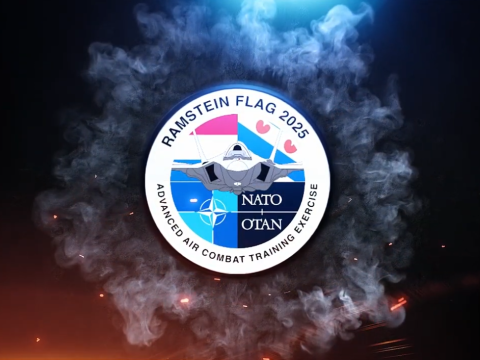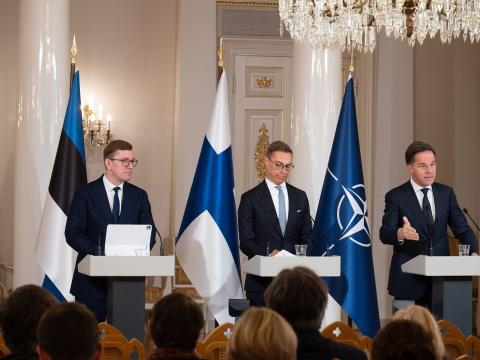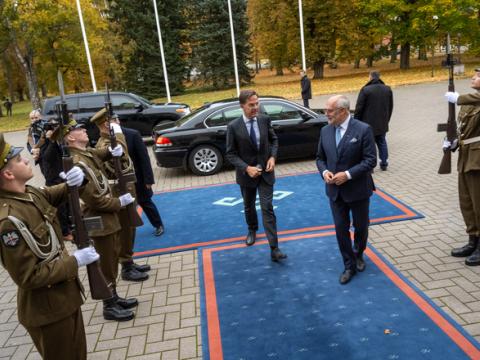President's Commentary: NATO Must Back Up Talk With Action
Deliberate discussion has always been the method of determining NATO policy and direction, but the window for that approach is narrowing. NATO must decisively confront several challenges.
The phrase, “These are critical times for the NATO alliance,” has been used so often it is almost a cliché. But these times are not defined by a cliché, as the alliance faces multiple challenges within and without. Deliberate discussion has always been the method of determining NATO policy and direction, but the window for that approach is narrowing. NATO must decisively confront several challenges.
Recently, the NATO framework has come under increased scrutiny and stress from friend and foe alike. Russia has made military moves into Georgia and Ukraine, annexing Crimea and intimidating the Baltic states. Countries that are NATO members have faced continuous pressure and intimidation from Russian influence operations. Key military leaders will readily admit that we are now in Phase III of military operations in the cyber domain.
Russian abhorrent behavior has a broad reach that must be checked. We have seen repeated incidents of nefarious activity, such as the nerve gas poisoning of former spy Sergei Skripal and his daughter Yulia, the meddling in national elections in the United States and throughout Europe, and the bold and aggressive military activity in Syria and the Black Sea, to cite a few examples. The Western world rightfully is concerned about Russia’s motives and its next move.
Against this backdrop, NATO’s relevance extends beyond its political components. Established for separate purposes, the alliance’s military strength underpins the economic activity of the European Union (EU) and beyond. While the EU has developed an aggressive vision for its own military force, that capability does not serve as a substitute for NATO.
Along with the economic, political and military strengths of NATO come the defining aspects of Western civilization that it buttresses: democratic values. These traditional values are under attack as never before, both internally and externally through diverse information influence campaigns. Many Western nations are facing popular movements that seek to undermine and discard decades of democratic-driven freedoms and norms. With the advent of social media and traditional propaganda methods, it is difficult for even the most informed citizens to decipher fact from fiction on a given topic. The Russians have proved to be masters at leveraging this uncertainty to meet their strategic goals of undermining Western democracies.
To complicate the challenge of values and thinking, China is taking bold steps to establish itself as a major influencer and player in European and Western political and economic activity. This often is subtle and under the radar. China’s dramatically increased interest in promoting Chinese-developed information technology into Europe, and its track record of intellectual property theft, should be a strong warning for NATO and the EU. If successful, China ultimately would be able to wreak havoc on global economic markets, not to mention the impact on European security.
With the rise of China, the dynamics of global security have changed, causing the United States to put increased emphasis on the Indo-Pacific security posture. All five major threats called out in the U.S. National Security Strategy have a strong presence in the Indo-Pacific region, and this emphasis serves not only U.S. interests, but also European interests. The alliance must increasingly think globally—beyond the continent. Activities in the Indo-Pacific region or Africa could have a major impact on NATO and EU countries alike.
Global threats offer opportunities for partnerships with like-principled nations. Japan, Australia, Korea and India, for example, share many common geopolitical interests and concerns with NATO. The Atlantic alliance and like nations could benefit from stronger relationships. Exchange programs leading to greater understanding through combined military exercises can lay the foundation for valuable partnerships.
To create a credible force, NATO’s modernization must address the looming changes in combat capabilities and operations. Several alliance members have militaries that are shells of what their capabilities should be. The NATO Readiness Initiative is a solid step in the right direction. The alliance must demonstrate a broad commitment to rebuilding its military capability to meet these challenges.
Accordingly, NATO must keep its eye on security investments. In 2014, member nations agreed to increase their military spending to reach 2 percent of each country’s respective gross domestic product (GDP), but progress toward this goal has been tepid at best. While some countries have made strides, many are still falling short. These nations must step up and accelerate investments in their own security.
NATO has been the shield of peace and stability in Europe and North America for 70 years, and its importance cannot be underestimated or taken for granted. To remain relevant, it must take timely and decisive measures to improve its effectiveness in the face of multiple global threats.




Comment
I agree that NATO needs to
I agree that NATO needs to come into the modern era of warfare. This means it must be able to engage in multi-domain operations across the board, not just with US, Canadian and UK forces. This means more high-level exercises to train member countries in such tactics and changes to military training throughout the organization.
Comments